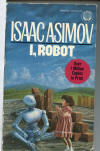|
|||||||
|
|
|
Home |

|
July 23rd: The Great I, Robot DiscussionBefore We Get to the I, Robot Discussion... We need to go over the midterm and finish discussing visuals from Ch. 6. I, Robot Study I did a study on I, Robot essays I acquired from students over a few years. As I've mentioned before in class, my approach to Technical Communication is not standard, so trying to pitch science fiction to the gatekeepers at the technical communication journals is difficult. Fortunately, the forward-thinker reviewers and editors at Computers and Composition found my article worthy to be published. Below is an excerpt from the article that presents the goals I have for incorporating I, Robot into the technical communication course: My goal for using Isaac Asimov’s novel I, Robot is to move students toward being aware that there are sub(altern) discourses about technologies—and not just computers. These discourses do not consider technology inherently progressive or essentially good. The novel’s setup fits in well with technical writing courses because, although it is 60 years old, it analyzes high-tech culture. Readers understand it as fiction, but they can be moved to read the novel’s subtext, which illuminates the ideologies carried out through the dominant culture’s beliefs and discourses about technology. When we adhere to strictly instrumentalist activities and lessons without critical analysis of the technical communicator-audience relationship, we may miss a major opportunity to engage our student population, a group that most likely—coming from engineering and sciences—has an uncritical view of technology: The mantra “bigger/smaller, faster, stronger, better” is not always accurate. In fact, it promotes a modernist paradigm for technical writing. Such a paradigm privileges the technologies over the communicators, much like system-centered design suggests that “the documentation is written to reflect the image of the system designer” (Johnson, 1998/2003, p. 295). Incorporating I, Robot into the technical writing classroom advances a postmodern pedagogy that privileges student agency and asks students to be critical of their own career goals when exploring the wider cultural forces that may shape their decisions and the products that their cultures produce. Toscano, Aaron A. (2011). Using I, Robot in the technical writing classroom: Developing a critical technological awareness. Computers and Composition 28(1), 14-27. [cited in APA format...I think] Specific/Starting Discussion Points Below I have a few images to get us thinking:
Here is the list of topics for your short essays. Asimov Links to Wikipedia I, Robot Cover--Runaround In order to bolster discussion, let's consider the following issues related to technology studies and, of course, technical communication:
Specific/Starting In groups of 2 or 3 (no more than 3), discuss two of the above topics that correspond to your row number (rows go front to back):
Future Work Next class we'll get back to research, so you should have read Ch. 8 in Tebeaux and Dragga. We'll continue our research discussion into Wednesday and Thursday. Also, your Set of Instructions are due Thursday (7/25).
..
|
||||||||||||||||||||||||||||||||||||||||||||
|
|
|||||||||||||||||||||||||||||||||||||||||||||
| © UNC Charlotte Copyright | Privacy Statement | Page Maintained By: Aaron A. Toscano |


